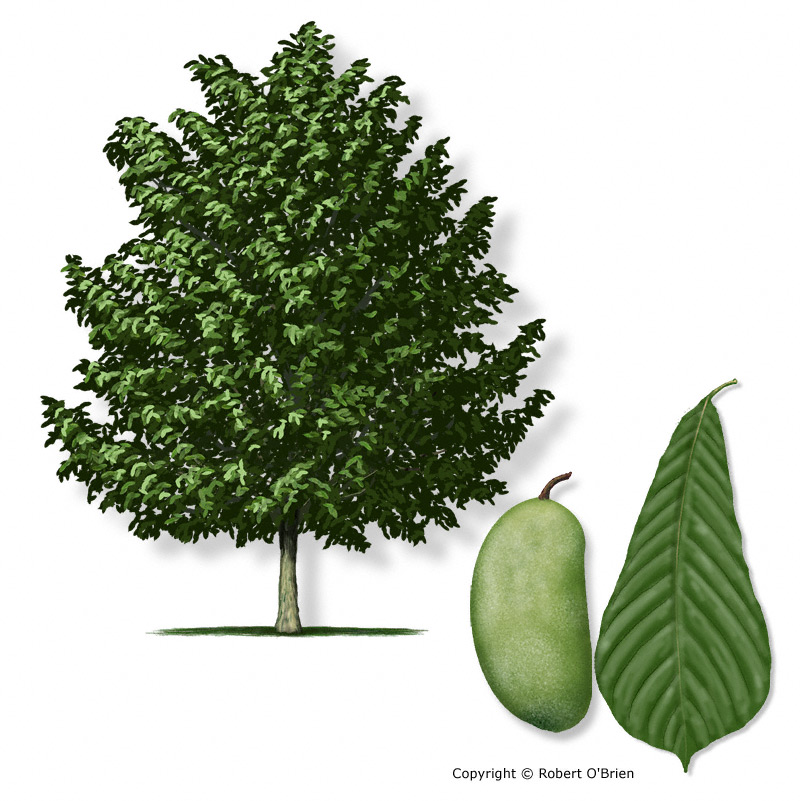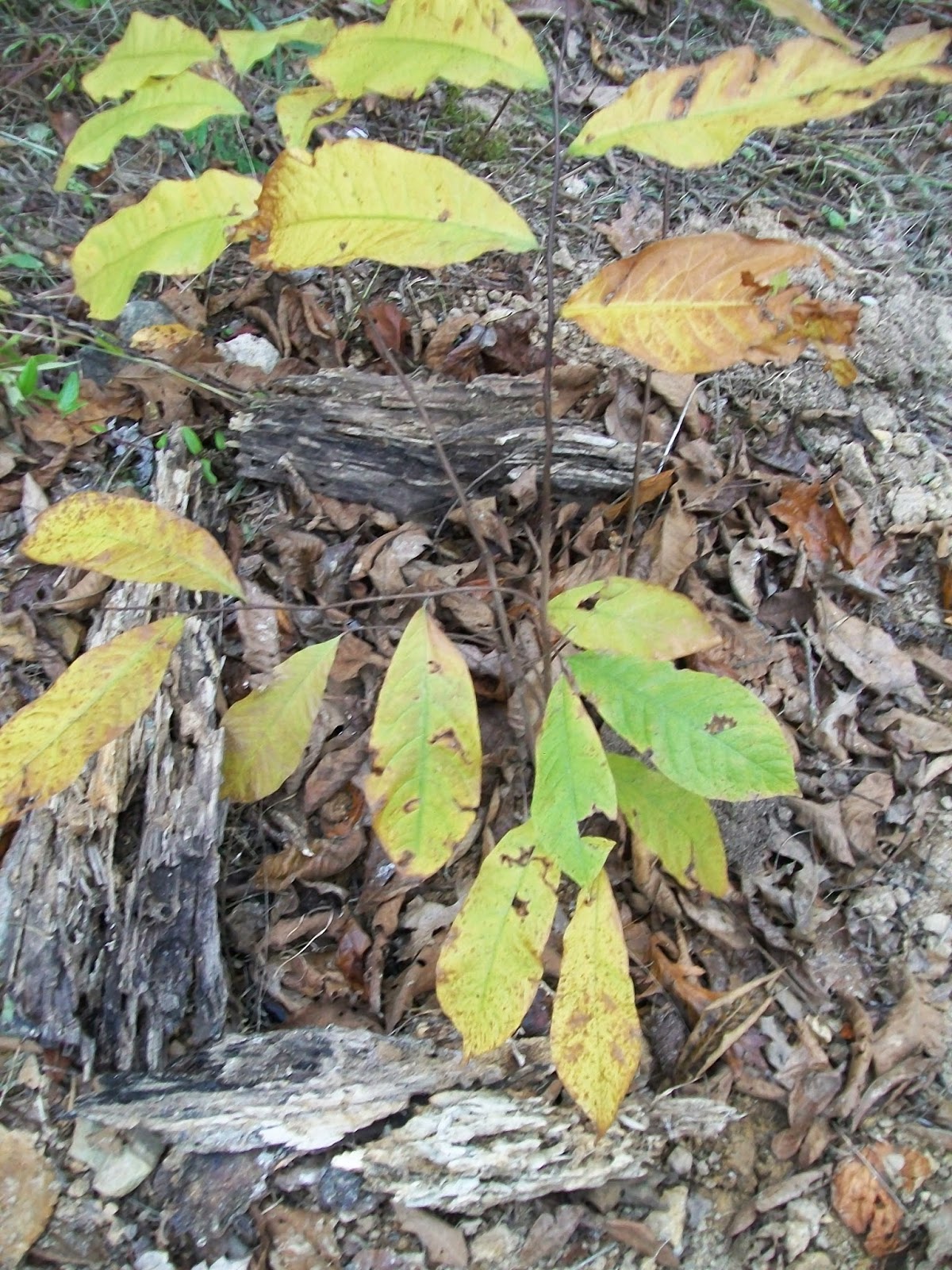For now I am expanding the garden by including new Fruit trees; mulching all the Fruit trees; cleaning up ivy around the property line; making raised beds with logs; and constructing Hugelkultur beds.
 I'll begin by talking about the Fruit trees I am transplanting. A native fruit to Kentucky, the Paw paw, can be found growing in damp, shady locations of wooded areas. My grandparent's have a small grove of Paw paws (over 100) in their woods. The trees have not started to fruit, either because they need a pollinator of a different variety of Paw paw, or they are still too young. Luckily, I (think) I have found a Paw paw grove in the woods behind my house. So I have transplanted five (young) Paw paw trees on my property, and soon I will transplant several Paw paws from my grandparent's woods. Paw paws are generally self-incompatible, so you need two
trees for cross-pollination. Plant at least two different cultivars or seedlings. Two
grafted trees of the same cultivar will not cross-pollinate. Hopefully because I transplanted young trees and because I will be planting two different varieties, the trees will grow quickly in the Full sun and produce fruit within the next couple of years.
I'll begin by talking about the Fruit trees I am transplanting. A native fruit to Kentucky, the Paw paw, can be found growing in damp, shady locations of wooded areas. My grandparent's have a small grove of Paw paws (over 100) in their woods. The trees have not started to fruit, either because they need a pollinator of a different variety of Paw paw, or they are still too young. Luckily, I (think) I have found a Paw paw grove in the woods behind my house. So I have transplanted five (young) Paw paw trees on my property, and soon I will transplant several Paw paws from my grandparent's woods. Paw paws are generally self-incompatible, so you need two
trees for cross-pollination. Plant at least two different cultivars or seedlings. Two
grafted trees of the same cultivar will not cross-pollinate. Hopefully because I transplanted young trees and because I will be planting two different varieties, the trees will grow quickly in the Full sun and produce fruit within the next couple of years. |
| Paw paw transplant |
 |
| This may be the only tree to survive transplant |
As stated I have already begun to clean up the bank for transplanting Paw Paw trees. I intend to transplant additional Nut and Fruit trees along the edge of the property line.
Because we have woods connected to our yard, along the edge becomes a wily mess of entanglement. I want to clean up the 3/4 of an acre, add mulch, cardboard and rock to "structure" the area, then dedicate every inch of the property to Fruit trees, vining Fruits, nut trees, Flowers, garden, a pond, Cob home, and solar panels.
The cleaning process is a lot of work because I am sourcing logs, sticks, leaves, soil, and native plants from the woods. I am able to create my projects for Free, but this takes much more manual labor. I am not buying soil or mulch from a big-box-store, I am collecting materials by hand, and carrying buckets (or barrels) of soil, leaves, rocks, and plants from the woods to my home. And I am carrying 80 lb logs from the woods to my home.
So you can see where these projects are a slow process, but beautiful and fulfilling nonetheless.
Secondly, I am practicing Hugelkultur methods within my first garden; and also making Hugelkultur raised beds in other locations of the yard. Hugelkultur, German word meaning mound culture or hill culture, where decaying wood debris and other compostable biomass plant materials are added to composting raised beds. For an explanation and example of Hugelkultur, watch this video by Paul Wheaton, here.
I'll
continue to update you on the progress of the Hugel beds. As you can
see in the photos below, the beds of logs, sticks, and leaves are the
first phases. Eventually, additional compost, leaves, and other
mulching material will be added to make nutrient-dense soil for planting.
I'll continue to update you on the progress of the Hugel beds. As you can see in the photos below, the beds of logs, sticks, and leaves are the first phases. Eventually, additional compost, leaves, and other mulching material will be added to make nutrient-dense soil for planting.
 |
| Phase 1 of Hugel bed 1 |
 |
| Phase 1 of Hugel bed 2 |
 |
| Phase 2 of Hugel bed 2 |
From the Pine trees (you see of the background in the photo below) I have collected Pine needles to use as mulch, which I have used on the 7 blueberry bushes you see in the photo.
 |
| Pine needles as mulch around blueberry bush |
 |
| Kieffer Pear |
 |
| Kieffer Pear |
 |
| Damson Plum |
 |
| Chicago Hardy Fig |
 |
| Chicago Hardy Fig |
 |
| Concord Grape |
 |
| Concord Grape |
 |
| 3 Strawberry beds mulched with pine needles |
 |
| Golden Jubilee Peach |
Perhaps I will have to resort to collecting leaves from the woods if I run out of leaves to rake around my yard! I'll also still collect logs and branches from the woods to use in the Hugelkultur mounds.
Although I do not count this as a gardening project or task, I am spreading the seeds of fruit, including pears, apples, and persimmons around my yard. All Summer I threw out Tomatoes and other rotting fruits around the yard rather than the compost to see if Volunteer plants come up. Hopefully I will see fruit trees spreading across the yard.
Of course other gardening tasks will keep me busy, such as cleaning up the property line of brush, ivy, over grown weeds. This will be a process over Winter which will include laying out plastic or cardboard along the property line, then adding rocks and mulching to create a presentable-look. Then I will plan to begin transplanting Nut and Fruit trees within these areas.
As if all these projects were enough to keep a woman busy for months, I have also started on digging the Trench for our Cob home, which you can see in this video: Digging outline for Cob home trench.
I highly encourage everyone to see the freedom and pride of growing food. Food is the number one necessity, and can even be linked to all the worlds problems. Eating the food with which you grew, and expanding this ideal to every household and every being could create a self-healing community.
Gardening can be a full-time job once you realize the potential of the land around you; and how much space you can utilize. Even 3/4 of an acre has the potential of feeding at least two people all year round. And because gardening can be absolutely as Free and primitive or expensive and technological as you desire, you can create a self-sustainable system which withdraws you from the greedy scheme of the 1 percent, lobbyists, government, and media.








No comments:
Post a Comment